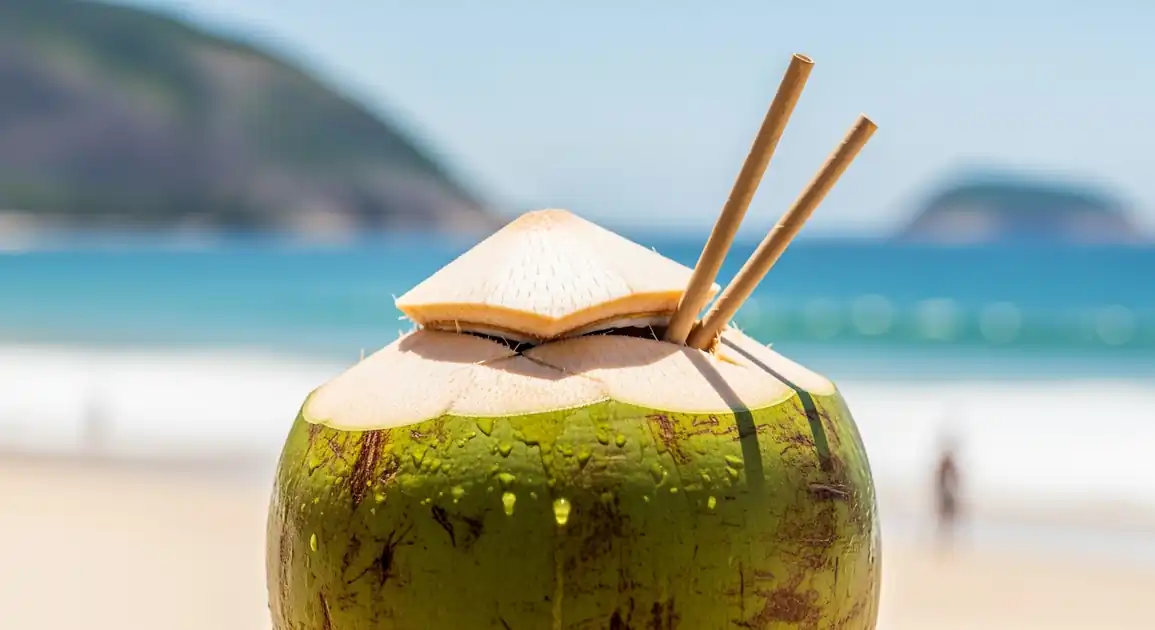Água de Coco (Coconut Water)
Água de Coco

Description
Água de Coco is synonymous with the Carioca lifestyle in Rio de Janeiro. Sold from ubiquitous kiosks ('quiosques') along its famous beaches like Copacabana and Ipanema, and by vendors in parks like Lagoa, it's the go-to refreshment for locals and tourists enjoying the city's outdoor culture.
Dietary Information
Serving information
Serving style
Iconically served in the green coconut with straws at beach kiosks and street carts.
Quick facts
Beach kiosks often operate from mid-morning (9-10 AM) until evening (6-7 PM or later). Street vendors typically daytime hours.
Safety Tips
What to Look For
-
Freshly opened coconut
Ensures the water inside is sterile and hasn't been contaminated after opening.
-
Chilled coconut ('bem gelada')
Improves taste and helps keep the water refreshing and safer in hot climates.
-
Clean knife/machete used for opening
Reduces the risk of transferring contaminants from the husk surface into the water.
-
Clean, preferably packaged, straws
Avoids contamination from dirty hands or straws left exposed.
-
Vendor with clean hands and cart
General hygiene is a good indicator of safe practices.
What to avoid
-
Pre-opened coconuts
Risk of contamination after opening. Always watch it being opened for you.
-
Coconuts with visible cracks or mold
Indicates potential spoilage or contamination of the water inside.
-
Dirty knife/machete
Can introduce bacteria directly into the coconut water.
-
Unwrapped straws handled with dirty hands
Easy way to transfer germs.
-
Coconut water that tastes sour, fermented, or off
Indicates spoilage; do not drink.
Price information
Price range
Budget tips
- Prices are highest at kiosks in the Zona Sul beaches (Copacabana, Ipanema, Leblon).
- Vendors away from the immediate beach front or in less touristy neighborhoods might be slightly cheaper.
- Supermarkets offer bottled versions at lower prices but lack the fresh experience.
Value indicators
- Served ice-cold ('estupidamente gelada').
- Heavy coconut indicating plenty of water.
- Clean vendor kiosk/cart and knife.
- Quick, skillful opening technique.
Where to Find This Dish
Copacabana & Leme Beaches
Countless kiosks along the entire length of the famous beach promenade.
Calçadão de Copacabana, Quiosques numerados
All day, especially sunny days
Ipanema & Leblon Beaches
Slightly more upscale kiosks and vendors along these beaches.
Calçadão de Ipanema/Leblon, Posto 9/10
All day, especially sunny days
Lagoa Rodrigo de Freitas
Vendors with carts stationed around the lagoon path, popular with joggers and cyclists.
Bike path around the lake, Parque dos Patins
Daytime, Weekends
City Parks & Squares
Vendors found in parks like Parque Lage, Quinta da Boa Vista, or busy squares in Centro.
Public parks, Praças
Daytime
Vendor Tips
- Kiosk prices are generally standard along a specific beach, but may vary slightly between beaches.
- Specify if you want a straw ('canudo') as vendors aim to reduce plastic. Bring reusable if possible.
- Enjoy the people-watching while sipping your coco at a beach kiosk.
How to Order
Regional Variations
-
'Coco Velho' Requests (Rare)
(Pedidos de Coco Velho (Raro))
While agua de coco uses green coconuts, very occasionally someone might specifically request water from a more mature coconut, but this is unusual for street vendors.
Cultural context
History
Coconut palms are abundant along Brazil's extensive coastline, and consuming coconut water has been a part of local life for centuries, valued for hydration in the tropical climate. It gained massive popularity as a natural health drink and beachside refreshment, becoming deeply integrated into Brazilian culture, particularly in coastal cities like Rio de Janeiro and Salvador. Commercial bottling increased its availability nationwide.
Local significance
The ultimate symbol of Rio's beach culture ('cultura praiana'). Represents a relaxed, healthy, outdoor lifestyle.
Eating customs
- Sipping slowly while relaxing on the beach or walking.
- Often the first stop for refreshment upon arriving at the beach.